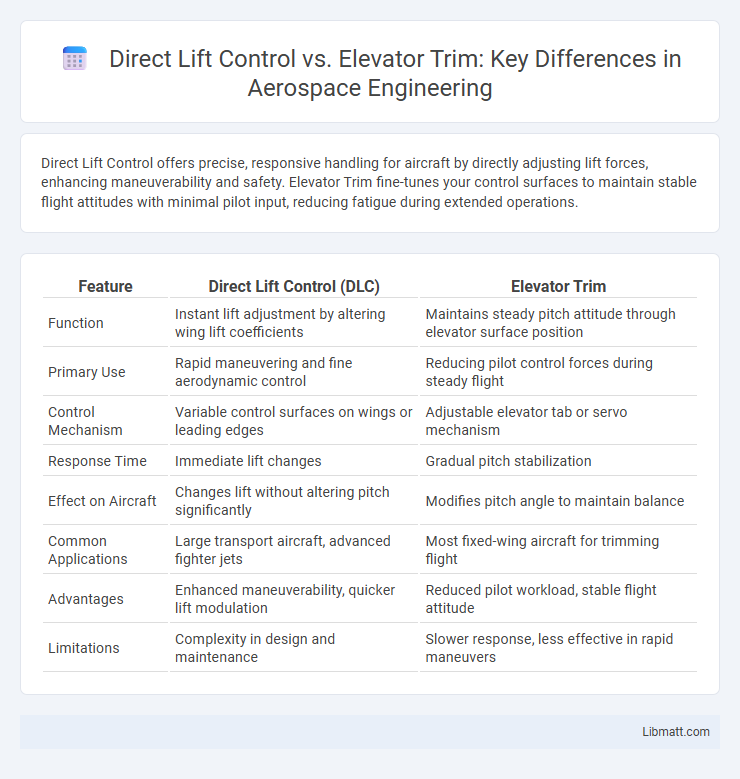Direct Lift Control offers precise, responsive handling for aircraft by directly adjusting lift forces, enhancing maneuverability and safety. Elevator Trim fine-tunes your control surfaces to maintain stable flight attitudes with minimal pilot input, reducing fatigue during extended operations.
Table of Comparison
| Feature | Direct Lift Control (DLC) | Elevator Trim |
|---|---|---|
| Function | Instant lift adjustment by altering wing lift coefficients | Maintains steady pitch attitude through elevator surface position |
| Primary Use | Rapid maneuvering and fine aerodynamic control | Reducing pilot control forces during steady flight |
| Control Mechanism | Variable control surfaces on wings or leading edges | Adjustable elevator tab or servo mechanism |
| Response Time | Immediate lift changes | Gradual pitch stabilization |
| Effect on Aircraft | Changes lift without altering pitch significantly | Modifies pitch angle to maintain balance |
| Common Applications | Large transport aircraft, advanced fighter jets | Most fixed-wing aircraft for trimming flight |
| Advantages | Enhanced maneuverability, quicker lift modulation | Reduced pilot workload, stable flight attitude |
| Limitations | Complexity in design and maintenance | Slower response, less effective in rapid maneuvers |
Introduction to Direct Lift Control and Elevator Trim
Direct Lift Control optimizes an aircraft's lift by adjusting control surfaces based on real-time aerodynamic data, enhancing stability and performance during various flight phases. Elevator Trim fine-tunes the elevator's neutral position to maintain steady pitch without continuous pilot input, reducing fatigue and improving flight efficiency. Your understanding of these systems helps ensure smoother handling and better fuel efficiency in diverse flying conditions.
Fundamental Concepts: How Aircraft Control Lift
Direct Lift Control (DLC) modifies lift rapidly by deploying discrete lift-enhancing devices, such as spoilers or leading-edge flaps, enabling precise control over aircraft pitch and descent rate without changing the main lift surface configuration. Elevator trim adjusts the neutral position of the elevator to maintain a desired pitch attitude, balancing aerodynamic forces for steady-state flight, reducing pilot workload during sustained flight conditions. While DLC offers immediate lift modulation for maneuvering or descent, elevator trim provides long-term stability by offsetting control pressures and maintaining equilibrium.
Working Principles of Direct Lift Control
Direct Lift Control operates by directly managing the hydraulic pressure or electrical signals to adjust the lifting mechanism in real-time, ensuring precise vertical movement without relying on secondary feedback systems. This method enhances responsiveness and stability by minimizing delay between control input and actuator response, unlike Elevator Trim, which adjusts balance after detecting positional changes. Your equipment benefits from smoother and more efficient lifts due to the immediate correction capability inherent in Direct Lift Control systems.
Elevator Trim: Function and Mechanisms
Elevator trim functions to maintain steady flight by counteracting control surface forces, reducing pilot workload during prolonged maneuvers. It operates through adjustable trim tabs or servo tabs on the elevator that alter aerodynamic forces, allowing the aircraft to hold a desired pitch attitude without constant control input. These mechanisms improve flight stability, enhance fuel efficiency, and optimize pilot comfort by minimizing control pressures.
Key Differences Between Direct Lift Control and Elevator Trim
Direct Lift Control adjusts the aircraft's lift directly by modifying aerodynamic surfaces or thrust to maintain altitude without altering the elevator position, enhancing stability and reducing pilot workload. Elevator Trim involves setting a neutral elevator position through trim tabs to maintain a steady pitch attitude, allowing for hands-off control during steady flight. The key difference lies in Direct Lift Control managing lift forces actively for immediate response, whereas Elevator Trim passively maintains pitch by balancing control surface forces.
Aircraft Types Utilizing Each System
Direct Lift Control (DLC) is primarily found on commercial airliners such as the Boeing 747 and McDonnell Douglas DC-9, where rapid pitch changes during approach improve landing stability. Elevator Trim systems are standard across a wide range of aircraft, including general aviation planes like the Cessna 172 and military fighters such as the F-16, enabling pilots to maintain a neutral control stick position without continuous input. The choice between DLC and Elevator Trim depends largely on aircraft design and operational requirements, with DLC favored in large jet transports for enhanced low-speed handling.
Impact on Aircraft Performance and Handling
Direct Lift Control (DLC) enhances aircraft performance by providing immediate adjustments to lift through spoilers, improving descent rate and stability without significant pitch change. Elevator trim optimizes handling by setting a neutral pitch attitude for hands-off flight, reducing pilot workload during cruise. Your choice between DLC and elevator trim affects how efficiently your aircraft responds to control inputs and maintains desired flight paths.
Advantages and Limitations of Direct Lift Control
Direct Lift Control offers precise, immediate adjustments to elevator pitch, enhancing aircraft stability and maneuverability, especially in dynamic flight conditions. Its primary advantages include reduced pilot workload and faster response times, contributing to improved safety and efficiency. However, limitations involve increased system complexity and potential maintenance challenges, which can lead to higher operational costs and require specialized training for effective use.
Elevator Trim: Benefits and Operational Considerations
Elevator trim improves aircraft stability by allowing pilots to adjust the neutral position of the elevator, reducing control forces and pilot fatigue during prolonged flights. Proper use of elevator trim enhances fuel efficiency by maintaining optimal pitch attitude without continuous control input. Your understanding of elevator trim benefits ensures smoother, more precise handling and efficient flight operations.
Future Trends in Aircraft Lift Control Technologies
Future trends in aircraft lift control technologies emphasize integrating Direct Lift Control (DLC) systems with advanced Elevator Trim automation to enhance aerodynamic efficiency and pilot workload management. Machine learning algorithms and real-time sensor data enable adaptive adjustments, optimizing lift and control surface deflections based on flight conditions. Your aircraft's safety and performance will benefit from these innovations through improved stability and fuel efficiency during critical phases like takeoff and landing.
Direct Lift Control vs Elevator Trim Infographic

 libmatt.com
libmatt.com